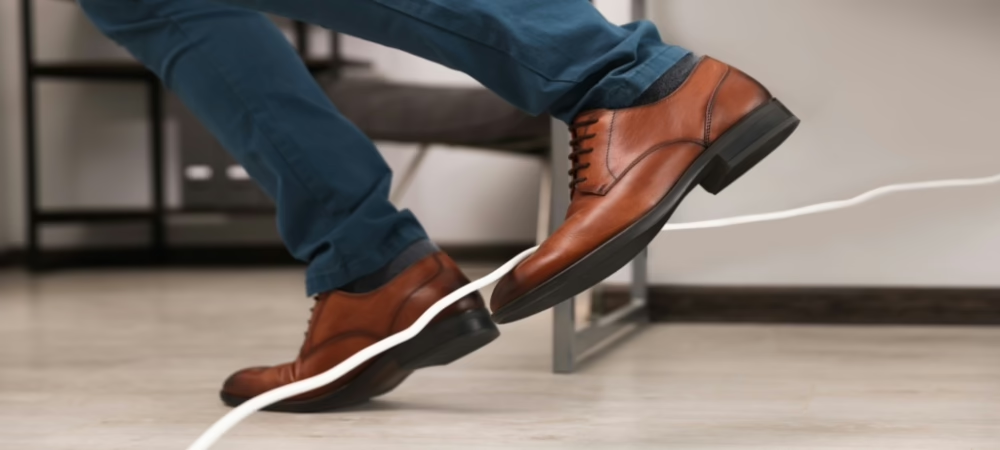5 Most Common Office Safety Hazards
Your office may be cozy and air-conditioned, but that still doesn’t mean everyone is safe in it. There are numerous safety risks and office hazards around every workstation. According to the Bureau of Labor Statistics (BLS), workers suffer tens of thousands of office-related injuries and health problems each year.
Every employer needs to be aware of common workplace hazards so they can take steps in eliminating them and making sure the odds of any workplace injury occurring are reduced to a minimum. Implementing processes and training that help identify hazards and correct problems is the safest thing upper management can do.
The Importance of Workplace Safety
Workplace injuries are costly for everyone. Across the United States, private companies reported a total of 2.7 million nonfatal injuries and illnesses in 2020, according to the BLS. Making matters worse, almost 5,000 people suffered fatal occupational injuries in the same year. Workplace injuries can be life-changing for employees, and it’s ultimately the employer’s responsibility to put the proper protocols in place to keep workers safe at all times.
The consequences of a workplace accident go far beyond the injuries themselves. The financial costs for employers can be extremely high, with the National Safety Council estimating that total workplace injuries cost U.S. companies almost $164 billion in 2020. Injuries also mean companies lose valuable, often highly experienced workers, causing productivity and morale to take a serious hit.
Considering the financial costs, employers stand to experience some significant benefits when they take occupational workplace safety seriously, including:
- Reducing accident-related costs: Workplace injuries can cause expenses like workers’ compensation premiums to go through the roof. A workplace safety program can help keep those costs in check while also reducing costs associated with lost talent and experience.
- Keeping hiring pipelines healthy: Employers that maintain a culture of workplace safety make themselves more attractive places to work. That means they’re much more easily able to attract the best talent for open job positions.
- Building more engaging workplaces: Workers who feel like their employers take their safety and well-being seriously are more engaged at work. Not only does that improve absentee and retention rates, but it also makes them more productive and efficient while on the job.
It’s clear that employers who invest in their office safety programs are best positioned to reap the rewards. But prioritizing workplace safety starts by understanding the most common office safety hazards facing employers and employees today.
The 5 Most Common Office Safety Hazards
1. Slipping, Tripping and Falling
Tripping, slipping, and falling may not sound like accidents that would pose big issues in an office setting, but unfortunately, that simply isn’t true. According to the National Safety Council (NSC), people are more than twice as likely to have a fall resulting in disabling injuries in an office environment than anywhere else.
Slips, trips, and falls are the most common causes of office injuries. The good news is, nearly all of them are preventable.
One of the most common situations where injuries from falls occur is when an employee uses improper ways to reach for something in a high place. Office workers often climb chairs and desks instead of using stepladders, which leads to frequent injuries.
Wiring that runs through the office is another example of unsafe conditions in the workplace because workers often trip over them.
2. Ergonomic Injuries
One of the most common types of hazards in a computer workstation is those that result in ergonomic injuries. Employees who work in an office spend hours at their desks, looking at their computers, which often results in various ergonomic strains and other posture injuries. The biggest problem with these health and safety hazards in the business environment is that they are often difficult to detect. However, they aren’t impossible to prevent.
Employees must have a vast range of adjustable chairs, ergonomic desks, keyboards, PC monitor holders, etc. for work. Office furniture and equipment should be adjusted to a wide range of work styles and working routines. Management should inform all office workers on how to operate with the adjustable equipment so they can benefit most from the ergonomic workstation.
OSHA offers a tool that illustrates general ergonomic guidelines for creating a proper computer workstation. For more information, read this office ergonomics post and download a screening tool.
3. Poor Lighting and Eye Strain
Poor lighting is one of the most common OHS hazards when using a computer. Bad office lighting can be a significant contributor to various vision-related illnesses as well as other health conditions.
One of the most obvious office hazard examples is low lighting which makes it hard to see hazards.
Poor lighting makes the list of safety risks at work because it often contributes to vision issues such as eyestrain and headaches. If untreated, eyestrain may lead to impaired vision. Inadequate lighting also contributes to employee stress levels and leads to increased sustainability to illnesses which leads to reduced productivity. Vision experts often suggest less bright lights placed overhead, and more localized lighting in each workstation.
Computer screens are another significant contributor to vision-related issues in the office. Workers who spend large portions of time in front of the screen can experience dry or irritated eyes if the light levels are unsuitable.
4. Indoor Air Pollution
Adequate ventilation is essential for providing employees with fresh air throughout their shifts. Dangers caused by air pollution take a high place on every list of office hazards. Poor indoor air quality causes occupational asthma and many other respiratory problems and allergies.
Some of the most common causes of poor office air quality include:
- Inadequate or outdated ventilation systems
- The presence of pesticides or cleaning chemicals in the office
- Overcrowded offices
- Poor housekeeping that leads to unclean workstations and environments
- Mold growth or water damage
- Too little or too much humidity
- Office design that blocks airflow
Proper maintenance, regular cleaning, and filtration of all systems – including the heating, air conditioning, and ventilating system – can greatly improve the air quality in your office.
5. Fire Safety
Training your workers in fire safety will prevent one of the most common office hazards. There are more fire-related office safety hazards than most employers imagine. In addition to the devastating potential for serious injuries and death, fire can destroy valuable equipment and documents. Preventing fire hazards in your office should be one of your highest priorities. Office materials are usually highly combustible, and many of them may emit toxic fumes when on fire.
Managers should be obligated to regularly check for fire hazards and find ways to minimize them. Regular inspections that include checking if all the cords are plugged in correctly and if all the fire extinguishers are easily approachable should be mandatory. This fire extinguisher short talk reviews how, when and if to use fire extinguishers.
How to Mitigate Workplace Safety Hazards
Understanding the most common office safety hazards is the first step. Creating a plan that helps you prevent those hazards from causing injuries is the next.
These are some of the most effective preventive measures you can implement to keep workers safe on the job:
Establish a safety program: An effective safety program ensures employees and employers alike have the tools and resources to maintain office safety and prevent injuries from happening. It includes all of the policies, procedures and processes designed to promote employee safety, as well as communication protocols to encourage feedback.
- Conduct a job hazard analysis: An important part of maintaining workplace safety is conducting a thorough job hazard analysis to identify the top recurring risks facing your employees. A job hazard analysis gives you a better understanding of each job function so you can put the right preventive strategies in place.
- Invest in workplace safety training: Job-specific training courses are the best way to tackle the most prevalent workplace hazards head-on and prevent injuries from ever happening in the first place. FFVA Mutual offers a range of safety training courses, from in-person sessions to online webcasts to fit any and all training.
If you’re looking to reduce office safety hazards and improve the quality of your office environment, FFVA Mutual is here to help! As leaders in workers’ compensation insurance, we’re proud to offer safety training resources including checklists, learning materials, and forms by topic, all backed by industry state links and respectful resources. Contact us to learn more.































